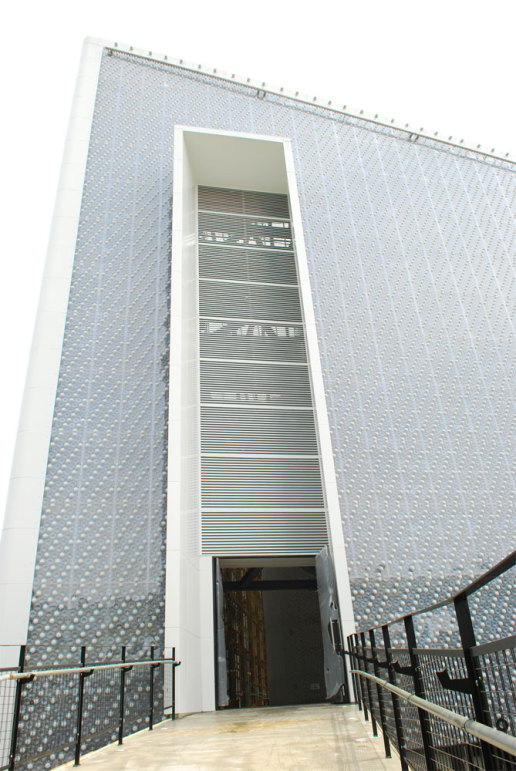
A good dose of grey matter and a bit of elbow grease
A 100% plastic house
After you have taken in the splendour of the Iguazu Falls, don’t forget to take a look at the “Casa ecologica de botellas” in Puerto Iguazu, Argentina, just a stone’s throw from the Falls.
Alfredo Santa Cruz and his family have built their house there using only recovered materials: they used 1,200 PET bottles to build the walls, 1,300 bricks from food packaging to make the roof, 140 CD cases for the doors and windows and, finally, 320 PET bottles for the furniture. Even the bed was made using 200 PET bottles!
 Alfredo’s intention is to show the enormous value of materials that are thrown away every day. “Household waste can be turned into useful stuff. We have developed our own technique, which enables people to build a perfectly functional house at a very low cost using their own hands.”
Alfredo’s intention is to show the enormous value of materials that are thrown away every day. “Household waste can be turned into useful stuff. We have developed our own technique, which enables people to build a perfectly functional house at a very low cost using their own hands.”
The initial project has turned into a socio-cultural, tourist and environmental project. In return for board and lodging and payment of transport costs, Alfredo Santa Cruz now provides his know-how to all those requesting it in his country.
Plastisoil, a new kind of concrete

In this case, how to maintain or repair roads and get rid of used plastic bottles? Naji Khoury and his colleagues at the Philadelphia Temple University had the idea of transforming this waste into a substance close to concrete which allows rainwater to be filtered better.
The PET bottles are sorted and cleaned, then reduced to flakes. The flakes are then mixed with mud, clay and gravel. The material obtained from this process, a sort of porous asphalt, has been christened Plastisoil. Naji Khoury claims that his invention can be used to lessen environmental problems linked to trickling rainwater. The substance could be used to make pavements, cycle and pedestrian paths and car parks. In addition, manufacturing Plastisoil would use less energy and work out cheaper than with the bitumen or cement traditionally used for roads and pavements.
6,000 bottles for a school in Guatemala
A little school with orange walls has been built in Guatemala. What makes it special is the fact that the walls were built with plastic bottles recovered from the village of Granados and its surroundings.
The project leader was Laura Kutner, a volunteer from the Peace Corps association who decided to serve two good causes at the same time: using plastic waste by turning it into a building material and providing walls for a school that did not have any!

 All the inhabitants of the village lent a hand: firstly, they filled the bottles with plastic bags, bits of packaging and other waste and placed them in a lightweight steel structure. Then, other bags were placed in the gaps, before being covered with cement.
All the inhabitants of the village lent a hand: firstly, they filled the bottles with plastic bags, bits of packaging and other waste and placed them in a lightweight steel structure. Then, other bags were placed in the gaps, before being covered with cement.
In the technique tried out by Laura, the bottles provide perfect insulation whilst the cement stabilises the whole thing, as with any conventional building.
The final touch is the orange paint, which makes this school a perfect example of “green construction”.
Byfusion, a machine for manufacturing bricks
 New Zealander Peter Lewis has devoted ten years of his time to develop a machine for producing bricks of tried and tested solidity from all types of plastic waste. Byfusion, as it is called, washes, dries and compresses the plastic to make bricks of ten kilos each, all in just 45 seconds!
New Zealander Peter Lewis has devoted ten years of his time to develop a machine for producing bricks of tried and tested solidity from all types of plastic waste. Byfusion, as it is called, washes, dries and compresses the plastic to make bricks of ten kilos each, all in just 45 seconds!
These bricks can be used to build retaining walls or for landscaping. The inventor also envisages other applications: shock absorbers behind crash barriers on roads and construction of emergency shelters in the event of natural catastrophes, etc.
MORE INFORMATION
lacasaecologicadebotellas@hotmail.com
http://sites.google.com/site/lacasadebotellas2/
www.temple.edu/engineering/research/labs/geotech
http://www.trashforpeace.org/
www.byfusion.com/






